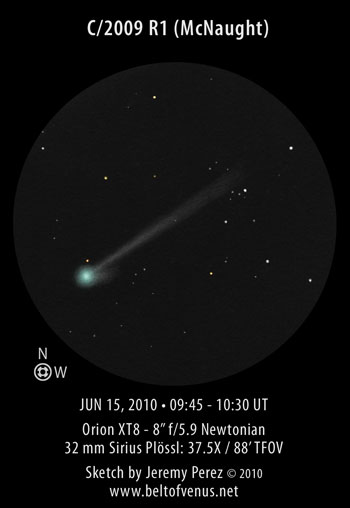
Sketch of comet C/2009 R1 (McNaught)
Move mouse over sketch above to view labels.
Click image for larger version.
Observation Notes:
I really enjoyed the view of the comet this morning with the 8 inch Dob, 15 x 70 binoculars, and naked eye. Through the telescope, the ion tail stretched about 45 arc minutes at PA 305 degrees. The dust tail also appeared as a westward smearing of the coma at a PA of about 270 degrees. The coma itself was a cool turquoise color that contrasted beautifully with an orange 8th magnitude star just to its north. I didn’t detect a distinct pseudo-nucleus, just a smooth rise in brightness toward the core.
The ion and dust tails showed up through binoculars as well. By comparing to two nearby stars of similar magnitude (TYC3330-3020-1 and TYC3330-2130-1) I estimated its magnitude at 5.7.
It was also visible to the naked eye, appearing as another faint star in Perseus.
| Subject | C/2009 R1 (McNaught) |
| Classification | Comet |
| Position* | Perseus: [RA: — / Dec: –] |
| Size | Coma: 10 arc minute diameter Degree of Condensation: 4 Ion Tail: 45 arc minutes at 305° Dust Tail: 10 arc minutes at 270° |
| Brightness* | est. 5.7 vMag |
| Date/Time | JUN 15, 2010, 2:45-3:30 AM MST (JUN 15, 2010, 09:45-10:30 UT) |
| Observing Loc. | Cinder Hills Overlook, Sunset Crater National Monument, Arizona, USA |
| Instrument | SkyQuest XT8 (8 inch f/5.9 Dobsonian); 15 x 70 Oberwerk Binoculars; Naked Eye |
| Eyepieces/Mag. | 32 mm Sirius Plössl, Pentax XW10, Pentax XW10+2X Barlow |
| Conditions | Clear, calm |
| Seeing | 2/10 Pickering |
| Transparency | Mag 7+ NELM |
| *Sources | Starry Night Pro Plus 5.8 |
